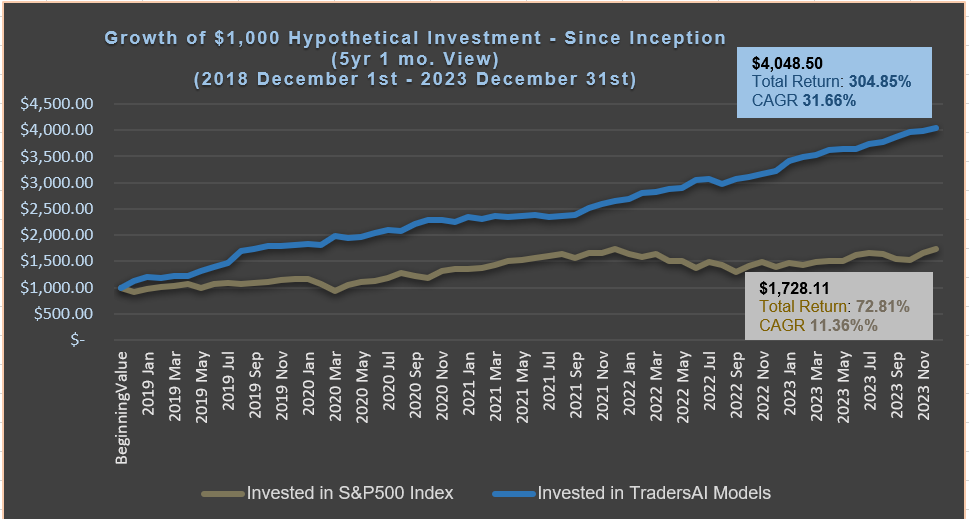Imminent New Record Highs – Day 2?
With no major economic releases scheduled barring this Wednesday’s release of the FOMC Meeting Minutes and Fed Chair Powell’s speech at Friday’s Jackson Hole Syposium, the major driver of the news headlines continue to be the US-China trade talks this week. S&P 500 Index seems poised to take advantage of any potential positive announcement or any talk of the likelihood of it as a pivot to jump into new record highs above 2872.87 – barring, of course, any unexpected negative geopolitical events.
Models indicate potential continuation of the recent bull run. The record highs registered in January this year are likely to be tested this week or next week. Whether it would be a sustained move up or a short lived one is to be determined based on the quality and the nature of the breakout – if and when it does happen.
Model Biases/Outlook:
On Monday, the S&P 500 Index closed just under 1 point away from the 2860 level our medium-term models indicated to go long. Nevertheless, the index posted a continued bullish momentum that remains intact albeit not strong.
Our models continue to sport slightly bullish bias until a break above 2863 or a daily close above 2860, at which point they would turn more bullish.
On the other hand, there is no bearish territory in sight until a daily close all the way below 2820. Between 2820 and 2860, it would continue to be in a choppy trading range, with an upward drift.
A Brief Trace Back of The Current Bias/Outlook
After 14 consecutive days of bearish bias, our models have negated the bearish bias on last Friday, 07/06/18 when it closed at 2759.82! Since then, our models have been consistently forecasting bullish strength and are yet to flash any concerns about any bears in sight, until Friday, 07/27.
After reiterating the bullish momentum for 21 consecutive days, our models abandoned the bullish bias with the action on last Friday 07/27, but have NOT replaced it with bearish bias yet. We were in this “neither bullish, nor bearish” state until Tue 08/07.
Eight days after the “neutral/indeterminate” bias, our models have resumed the bullish bias as of Tue 08/07. We continue this (slightly) bullish bias for the fourteenth day on Tuesday 08/21.
Trading Plans for TUE, 08/21:
Medium-term/long-term Investors
Medium term models indicate a slightly bullish state for the S&P 500 Index. The models are currently flat (no positions) and are waiting for a break out to go long.
For today’s regular session, the medium term models indicate going long on a break above the index level of 2860, with a 10-point trailing stop. No bearish bias until all the way below 2820. Meditum-term models indicate waiting for a daily close below 2820 to turn bearish.
Remember that a “trailing stop” works differently from the traditional stop-loss order. Please bear in mind that the trailing stop’s trigger level would keep changing throughout the session (click here to read on the conceptual workings of a trailing-stop).
Aggressive, Short-term, Intraday, or Professional Traders
Intraday aggressive models indicate a “slightly bullish” state for the S&P 500 Index for the day. The models are currently long from the position bought on Friday on a break above 2845 (at 2845.25) with the 6-point trailing stop last anchored – as of Friday’s close – at 2849.63 on the index level (index high on Friday at 2855.63).
On Monday, the index registered a low of 2850.62, that is just one point away from hitting the trailing, and consequently the models are carrying the long position into Tuesday. Based on the 2859.76 high posted on Monday, the long position currently has the 6-point trailing stop anchored at 2853.76, guaranteeing a profit of 8+ points if the market hits that level.
If the trailing stop triggers and the models go flat, they indicate further trading off of 2865-2838 as the pivot band. Above 2865, the models would go long (buy) with a tight trailing stop (about 6 points). Below 2838, models would go short (sell) with a tight trailing stop (about 6 points).
To avoid getting caught up in whipsaws and overtrading, wait for a confirmation of the breakout of these levels on at least a 15/5/1 minute bar or two, depending on your trading style and risk profile.
Remember that a “trailing stop” works differently from the traditional stop-loss order. Please bear in mind that the trailing stop’s trigger level would keep changing throughout the session (click here to read on the conceptual workings of a trailing-stop).
IMPORTANT RISK DISCLOSURES AND NOTICES – READ CAREFULLY:
(i) This article contains personal opinions of the author and is NOT representative of any organization(s) he may be affiliated with. This article is solely intended for informational and educational purposes only. It is NOT any specific advice or recommendation or solicitation to purchase or sell or cause any transaction in any specific investment instruments at any specific price levels, but it is a generic analysis of the instruments mentioned.
(ii) Do NOT make your financial investment or trading decisions based on this article; anyone doing so shall do so solely at their own risk. The author will NOT be responsible for any losses or loss of potential gains arising from any investments/trades made based on the opinions, forecasts or other information contained in this article.
(iii) Risk Warning: Investing, trading in S&P 500 Index – spot, futures, or options or in any other synthetic form – or its component stocks carries inherent risk of loss. Trading in leveraged instruments such as futures carries much hi
gher risk of significant losses and you may lose more than you invested in them. Carefully consider your individual financial situation and investment objectives before investing in any financial instruments. If you are not a professional trader, consult a professional investment advisor before making your investment decisions.
(iv) Past performance: This article may contain references to past performance of hypothetical trades or past forecasts, which should NOT be taken as any representation or promise or guarantee of potential future profits. Past performance is not indicative of future performance.
(v) The author makes no representations whatsoever and assumes no responsibility as to the suitability, accuracy, completeness or validity of the information or the forecasts provided.
(vi) All opinions expressed herein are subject to change at any time, without any notice to anyone.





